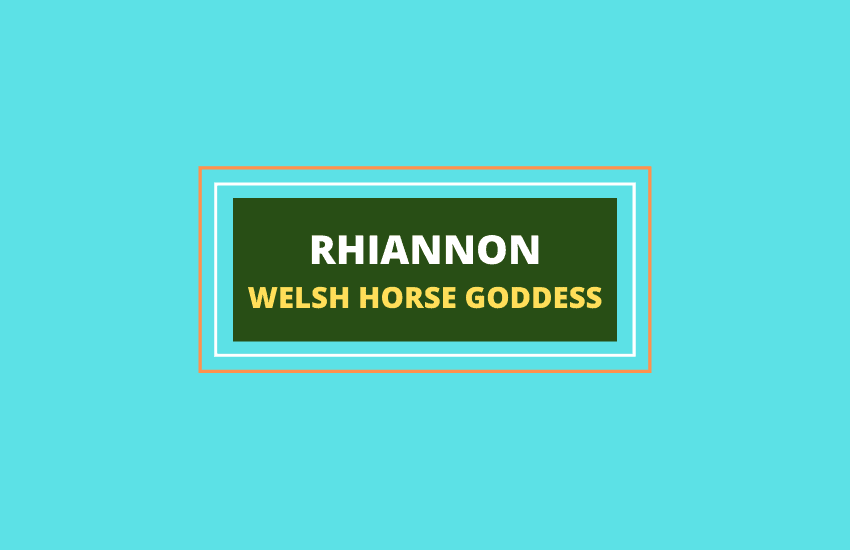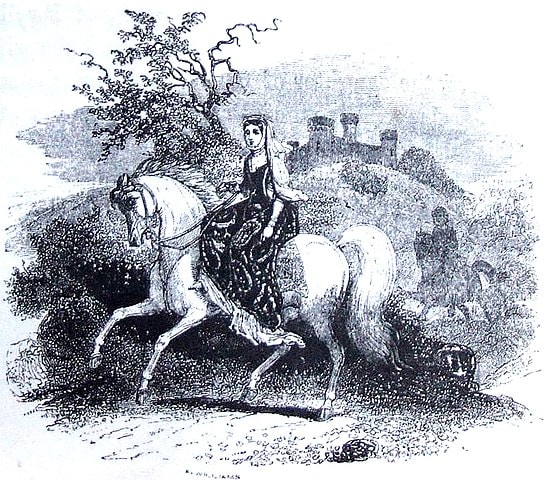
Table of Contents
Rhiannon, also known as Great Queen and White Witch, is an inspiring character in Celtic mythology, who possesses deep magic and can manifest her desires and dreams for the good of herself and others.
In the medieval stories of Wales, better known as Mabinogion, Rhiannon is portrayed as a horse goddess, in many ways similar to Gaulish Epona and the Irish Macha goddess. Here’s her story.
Rhiannon’s Role in Mabinogion

Rhiannon’s story begins with her decision to marry a man of her choosing. Despite her family’s wishes, Rhiannon refused to marry the older man Gwawl, one of her kind, because she found him repugnant. Instead, she married Pwyll, the mortal lord of Dyfed.
- Pwyll sees Rhiannon
One day, Pwyll was out with his companions riding a horse, and he spotted Rhiannon, galloping on her white mare. The young lord was immediately enchanted by the beautiful goddess dressed in gold.
Pwyll sent his servant on the fastest horse he could find to go after her and ask her if she would want to meet the enchanted prince. However, the servant couldn’t catch up with her, as her horse was so powerful and swift, that it seemed as though it was barely touching the ground.
Ignoring his friends’ protests, Pwyll went after her alone the next day. He pursued her for three days and couldn’t overtake her. Finally, as his horse started to tremble, Pwyll decided to stop chasing her and called her to stop and wait for him. And she did so.
She told him she would marry him, but that they had to wait one year. After one year had passed, Rhiannon appeared on the same mound in the same golden dress to greet the prince. She guided him and his men into the tangled woods.
- Rhiannon and Pwyll get married
When they reached the clearing, a flock of magical songbirds joined them, flying playfully around the goddess’ head. They had a beautiful wedding at her father’s crystal castle that was surrounded by a lake and soared into the sky.
But the man she was promised to, Gwawl, started making a scene, and Rhiannon turned him into a badger, wrapped him in a bag, and threw him into the deep lake. However, he managed to escape, and would cause havoc later in Rhiannon’s life.
- Rhiannon’s Child
After three years of a happy marriage, Rhiannon gave birth to a fine and healthy baby boy. Six women were tasked with taking care of the infant while the queen was resting. But, one night, they all fell asleep. When they woke up, they realized that the cradle was empty.
To escape severe punishment, the women servants devised a plan to make Rhiannon look guilty. They killed a puppy and smeared his blood all over the sleeping goddess, accusing her of eating her own infant son.
- Rhiannon’s Punishment
Rhiannon was condemned for her supposed actions and was to be killed. Pwyll begged the others to spare his wife’s life. Instead, as penance, Rhiannon had to sit at the castle’s gates for the next seven years, wearing a heavy horse collar and greeting the guests. She was obliged to tell them what she had done and escort them into the castle on her back. At the beginning of the fourth year of her punishment, a nobleman, his wife, and a young boy came to the gate.
- Rhiannon is redeemed
The boy turned out to be Rhiannon and Pwyll’s son.
The legend says that, four years ago, the noblemen found the abandoned infant in the woods and raised him as his own. Some believed that it was Rhiannon’s suitor, Gwawl, who kidnapped the baby as an act of revenge.
Rhiannon was quickly back at her husband’s side, and her honor was restored. As she was noble, full of forgiveness and understanding, she didn’t hold a grudge against Pwyll and his people for what they had done to her because she saw they were truly ashamed.
The Symbols of the Goddess Rhiannon
The Celtic goddess Rhiannon, also known as the Great Queen of fairies, was born at the rise of the first Moon. She represents wisdom, rebirth, compassion, beauty, poetry, and artistic inspiration.
She often manifests as a gorgeous young woman, dressed in a glittering gold gown, galloping on her powerful pale white horse, with mystical singing birds flying around her. According to Welsh folklore, the birds’ magical songs had the power to wake the spirits of the dead and grant dreams to the living.
The moon, horses, horseshoes, birds, gates, and wind are sacred to Rhiannon, and each of them has a specific symbolic meaning:
- The Moon
Rhiannon is often associated with the Moon and is sometimes referred to as the Moon Goddess or The Goddess of Fertility. In this context, she’s seen as a deity that represents motherhood, rebirth, and creation. In modern paganism, the lunar symbology where the three phases of the moon, the waxing phase, the full moon, and the waning moon, refer to the Triple Goddess, representing the Mother, Maiden, and Crone. It symbolizes the cosmic cycle and the eternal processes of life, death, and rebirth.
- Horses
The Goddess is often depicted traveling the earth on a powerful and swift white horse. As free spirits, horses symbolize travel, movement, and freedom. The Rhiannon’s white mare represents leadership, fertility, and the means to set in motion everything that may be stagnant.
- Horseshoe
The horseshoe is perhaps the best-known symbol of good luck. It also has a long history of having protective powers. As an auspicious symbol, it’s often used as a good luck charm that protects against evil and brings positive energy.
- The singing birds
Rhiannon is usually accompanied by a flock of magical singing starlings that possess supernatural powers and whose song can lull the living into slumber and wake the spirits of the dead from their never-ending sleep. In Celtic mythology, birds are a mighty force, symbolizing the journey of the spirits to the Otherworld. They represent the idea of freedom and reincarnation, as they guide the liberated souls of the dead to the afterlife.
- The Gate
As the goddess has the power to wake the dead, and lull the living into a permanent slumber, she’s seen as the keeper of the world in between and the gate that connects life and death. Symbolically, Rhiannon was sentenced to serve a 7-year long punishment at the castle’s gate and was very forgiving towards those who wrongfully accused her. In this context, the gate represents righteousness, mercy, and justice.
- The Wind
As the goddess travels swiftly on her horse, she’s often associated with the air and wind. Invisible but powerful, the wind has strong effects on other elements. It represents movement, the divine intervention, and the vital spirit of the universe.
Lesson Learned from Rhiannon’s Story
The goddess’ story and her unjust punishment teach us many valuable lessons:
- Patience and endurance – Rhiannon endured four long years of cruel punishment with dignity and grace. Her actions remind us of the power of patience and endurance. Although these traits are difficult to master in our fast, modern lives, Rhiannon’s story assures us that with patience, all the injustices and pains we suffer will eventually align with the universe and be brought to balance.
- Divinity and forgiveness – Her story helps us to identify the compassion and divinity within ourselves. With practicing patience and forgiveness, the goddess shows that it’s possible to cast aside the victim’s role from our lives, outshine injustice, and stop blaming others for our troubles.
- Power of change – The goddess’s story reveals that no matter how grim life can be, transformation and change are possible with true love and sincere intention. She reminds us that we have the power to create any change we seek.
To Wrap Up
Rhiannon, the Great Queen, is a healer, a dreamer, and a traveler. She’s as brave and beautiful as she is patient. As a symbol of beauty, rebirth, wisdom, and compassion, she teaches us kindness, divinity, and forgiveness.








